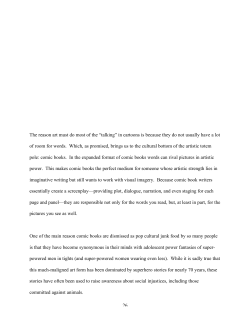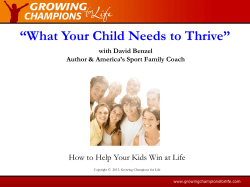
JS March 16, 2015, Wonder Woman Lexile
american history Wonde L ike any superhero should, Wonder Woman came along at just the right time. She first appeared in the fall of 1941. World War II had been raging in Europe for two years. The United States had managed to stay out of the fighting so far. When All-Star Comics No. 8 hit American news- stands that fall, the kids who grabbed it off the racks had no idea that the U.S. would join the conflict in a few weeks. But they quickly realized that something new and exciting was going on in a nine-page story called “Introducing Wonder Woman.” It appeared near the back of the 76-page comic book. 14 JUNIOR SCHOLASTIC / March 16, 2015 er Woman The story behind the most popular female superhero of all time 1941 Courtesy of DC Entertainment (Wonder Woman); Heritage Auction (Sketches) These are the first sketches of Wonder Woman that illustrator Harry G. Peter sent to William Moulton Marston, her creator. By the end of that story, a powerful Amazon warrior princess named Diana has adopted the U.S. as her new home. Her superhero costume includes an American eagle and the red, white, blue, and stars of the U.S. flag. She is ready to help America defeat the evil force that is threatening Europe and the world: the Nazis. Wonder Woman was an immediate hit with boys and girls alike. Along with Superman and Batman, she is still one of the most recognizable superheroes worldwide. They are the only three comic-book superheroes to have been pub- lished almost nonstop since their first appearance. “To Inspire Girls to Self-Confidence” Wonder Woman was the brainchild of William Moulton Marston, a psychologist from Rye, New York. Marston’s previous claim to fame was developing one of the first lie-detector machines. Marston entered the comics business in 1940, when the publisher of Superman comics hired him as an adviser. Comic books were new at the time, but they were already under attack by adults who feared that comics were a bad influence on children. Marston, however, believed that comics could help give positive values to kids. He wasn’t satisfied with just giving advice. He came up with a new character, Wonder Woman. Then, as now, most comicbook characters were male. The few female characters were minor players with limited powers. The first Hawkgirl, for instance, was the girlfriend of Hawkman. Sometimes she would wear a spare set of his wings and his anti-gravity belt. She did it to trick bad guys into thinking that she was Hawkman. But she had no power or authority of her own. Marston had been a supporter of women’s rights since his college days. “The only hope for civilization is the greater freedom, development and equality of women in all fields of human activity,” he wrote in 1942, when he let people know he was Wonder Woman’s author. (He published her adventures under the pen name Charles Moulton.) Marston’s Wonder Woman was the equal of any male superhero. Her superpowers were her great strength, speed, and smarts. She also could fly. She wore bracelets that deflected bullets. Her tiara could be used as a boomerang. Her magic lasso forced anyone caught in its grip to tell the truth. continued on p. 16 March 16, 2015 / JUNIOR SCHOLASTIC 15 1942 Still more workers were needed, so an ad campaign targeted women. A famous poster showed a character called Rosie the Riveter. She flexed a Wonder Woman-like muscle and declared, “We Can Do It!” In May 1942, a new law created the nation’s first military unit for women. More than 150,000 women joined the Women’s Army Corps, serving in noncombat support roles. Other armed service branches soon created their own female units. Losing Her Powers In 1945, World War II ended, and American men came flooding home. Many working women lost their jobs to the returning GIs. Wonder Woman also lost power. Marston died in 1947. The new writers and editors didn’t have the same ideas about “strong, free, courageous womanhood.” Wonder Woman spent less time fighting bad NATIONAL ARCHIVES/AP Images (Rosie the Riveter); Courtesy of Marvel Comics (Ms. Marvel) next day, Congress Marston said his declared war on Japan goal was “to set up a and, three days after standard among chilthat, on Germany dren and young people and Italy. By the time of strong, free, couraWonder Woman geous womanhood. appeared on the cover He wanted “to combat of the January 1942 the idea that women Sensation Comics are inferior to men, No. 1, the U.S. had and to inspire girls to During World entered World War II. self-confidence and War II, Rosie the achievement in athlet- Riveter called on women to keep America running by ics, occupations, and Real Women taking on jobs held by men professions monopoat War before the war. lized by men.” While Wonder Those ideals may not seem Woman was busy outsmarting and unusual today, but they were far overpowering bad guys in the from common at the time. In 1941, comics, real women were doing few women worked outside the their part for the war effort. In 1942 home. The 19th Amendment, which alone, more than 2 million women guaranteed women’s right to vote, poured into the workforce to do the had been in effect only 21 years. jobs of men who had gone off to On December 7, 1941, soon after fight. Women ran farms and factoWonder Woman first appeared, ries. They built ships, planes, Japan bombed Pearl Harbor. The tanks, and weapons. Count Us In! 2014 Meet the new Ms. Marvel, a Muslim teenager from New Jersey. 16 JUNIOR SCHOLASTIC / March 16, 2015 photo credti tk O ther female superheroes have made their way onto the pages of comic books over the years. Many were based on established male characters—Supergirl from Superman, for instance. Some were members of male-dominated teams, such as the Fantastic Four’s Invisible Girl (later Invisible Woman). But no female characters ever became as popular as Wonder Woman, and publishers did little to develop them. These days, though, comics are big business. Hollywood is mining them for movies, and more women and girls are saying, “Hey, what about us?” DC and Marvel, the two biggest comic-book publishers, are finally listening. A new raft of female superheroes has arrived, but gender isn’t the only change you’ll see in today’s comic books. The superhero universe is now more diverse than ever. Take the new Ms. Marvel (left). Her secret identity is Kamala Khan, a Muslim Pakistani-American teenager. After Peter Parker died, the role of Spider-Man was taken over by Miles Morales, who’s halfblack, half-Hispanic. Captain America is also African-American. There are Asian superheroes too, including Yukio, a Japanese martial-arts expert who’s in a wheelchair. What kinds of superheroes would you like to see? Super Facts guys and more time as a regular person called Diana Prince. In 1968, the writers did away with Wonder Woman’s powers completely. They kept her in her Diana Prince role. But the women’s liberation movement of the 1960s and 1970s was brewing. Women were demanding stronger female role models. In 1972, a new feminist magazine called Ms. turned to an old ideal: Wonder Woman as she used to be. The cover of the first regular issue of Ms. showed her as huge and powerful, striding under a headline that said WONDER WOMAN FOR PRESIDENT. In time, Wonder Woman got her powers back in the comic books too. superman, The first superhero, was created by two Teens from Cleveland in 1938. Jerry Siegel and Joe Shuster had no idea he would be a huge hit and spawn countless imitations. They sold the rights to Superman to the company that became DC Comics for $130. Captain America started out fighting nazis. In his 1941 debut, he knocked out Adolf Hitler with a mighty punch! Marvel stopped publishing Cap in 1950 but brought him back in 1964—and he’s been popular ever since. Courtesy of DC Entertainment (Action Comics); Mim Friday/Alamy (Captain America); Bettmann/CORBIS (Congress); Gabriel Olsen/Getty Images (Comic-Con) What Kind of Hero? Today, there’s a new wave of debate over what female super heroes should be like. Some people say that too much emphasis is placed on physical beauty, skimpy outfits, and sexy poses, and not enough on smarts and strength. As Bryony Gordon, a journalist, puts it: “Why do all female superheroes have to do cartwheels in corsets and skin-tight catsuits?” But others say that Wonder Woman can still be a positive role model. Psychiatrist Jean Kim recalls how playing Wonder Woman gave her confidence as a kid. “[The boys] would play Batman or Spider-Man, and I could be a perfect Wonder Woman, k icking like I had tall red boots on. I even made my own perfect magic lasso,” Kim wrote in Psychology Today. “Her influence on my self-esteem and my future aspirations cannot be undervalued. Sometimes these pop cultural images and role models matter.” —Kathy Wilmore Congress InvestigateD comic books. Some parents and educators saw comic books as a bad influence on kids. Protests led the Senate Subcommittee on Juvenile Delinquency to investigate the industry in 1954. In response, publishers established the Comics Code Authority to set new ethics standards for comic books. Comic books are hot again. After years of flagging sales, adults raised on comic books started buying them again. In 1970, a group of fans organized a comics convention in San Diego, California. With conventions now held all over the world, Comic-Con brings together comics creators, movie and TV stars, and thousands of fans—with many dressed as their favorite characters. March 16, 2015 / JUNIOR SCHOLASTIC 17
© Copyright 2025













